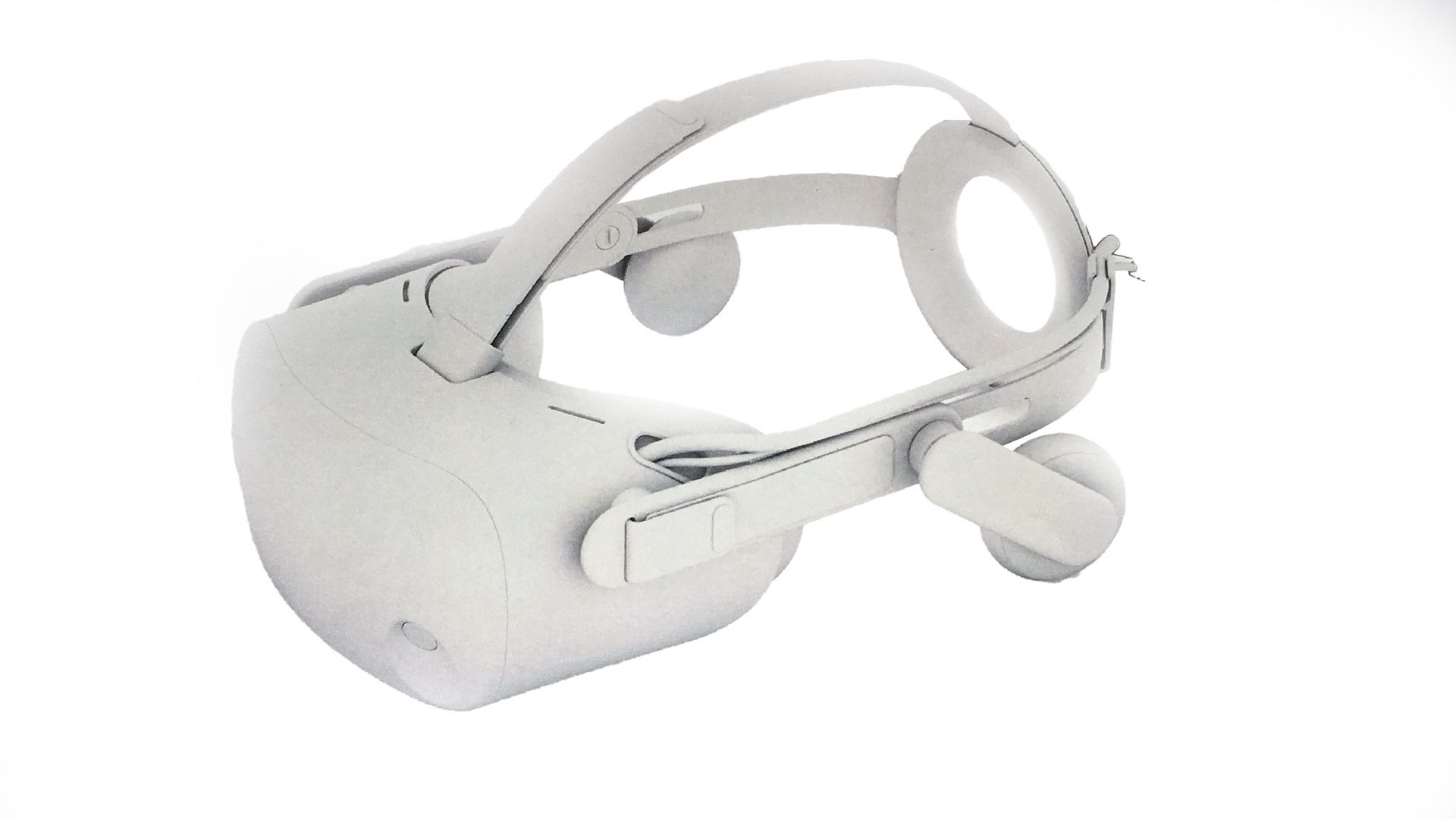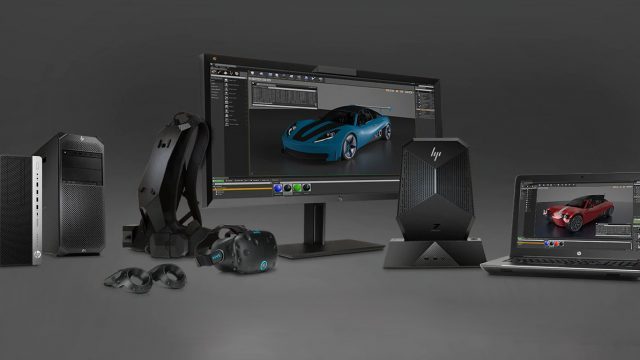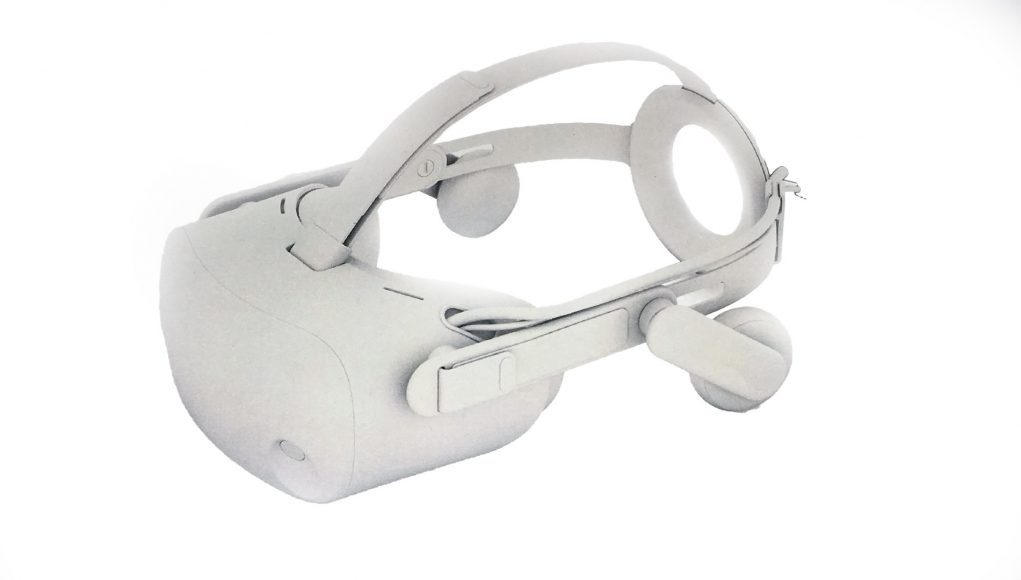Having launched its first VR headset in late 2017, alongside a handful of similar headsets as part of Microsoft’s Windows Mixed Reality platform, HP is preparing to take its next step with the launch of a new headset that diverges from the pack. Road to VR got an exclusive preview of the so far unannounced and unnamed headset which the company hopes will raise the bar on clarity and comfort.
It was a seemingly fitting day—unusually dreary weather for California’s Bay Area—to find myself in the basement of HP’s Palo Alto headquarters, safe from the wind and rain. After being led through secure doors, down an elevator, and along a maze of white hallways, I found myself inside a windowless bunker of a room: HP’s VR Lab, I’m told.
Inside, past a row of computers with various consumer headsets attached, I see two identical laptops sitting on a table off to the side. They’re powered up, with a long tether leading to a headset sitting in front of each. The first I recognize: Samsung’s recently launched Odyssey+. The second easily could’ve been mistaken for a Rift at first glance, but upon closer inspection would prove to be something much different.
Microsoft launched its Windows Mixed Reality platform back in late 2017 alongside a salvo of VR headsets from partner companies (HP, Acer, Dell, Lenovo, and Samsung) which work with the platform. Among that initial set of headsets, all but Samsung’s was built to nearly identical specifications, apparently based around a reference design primarily developed by Microsoft. That left little to differentiate the launch headsets (other than Samsung’s) beyond aesthetics.
This time around, HP is owning the design of its next-gen headset from the ground up. It’s still a Windows Mixed Reality headset—which means it retains the same quality inside-out tracking and ease of setup which the platform is known for (thanks to not needing any external trackers)—but beyond that, HP has crafted a significant departure from its first headset.
‘Copper’, as it’s codenamed, has a distinct Rift-like look to it; a slim, top-strap design with sleek headphones attached to the headband. Upon closer inspection, the rear of the headset sees the top and side straps culminate in a circular structure (designed to cup the back of your head), while the front is encompassed by a heathered material into which the front-facing cameras are embedded.
I wasn’t allowed to take any photos—after all, HP has yet to officially announce the headset; the company would only share a single untextured rendering. But the headset I saw already looked and felt nearly market-ready, despite still being under wraps.

That’s because the device I tried is the very first tooled prototype, said John Ludwig, Product Manager for VR at HP, which means the company is already well on its way to doing production runs of Copper.
Ludwig, who has been closely involved with the development of the headset, walked me through a demo where I strolled around a real-time pre-visualization of an architectural design. Confident in the clarity I’d see through Copper’s lenses, he offered up the Odyssey+ as a side-by-side comparison (currently the highest res WMR headset on the market at 1,440 × 1,600 per-eye). Indeed, Copper’s clarity blew it away.
That’s no doubt primarily driven by Copper’s 2,160 × 2,160 (per eye) displays, which have more than twice the number of pixels as the Odyssey+, and more than three and a half times as many pixels as first-gen headsets like the Rift. Looking through Copper’s lenses, sharpness is a drastic step forward over Odyssey+. And while the Odyssey+ uses a diffuser on the screen (which sacrifices some sharpness in an effort to hide the screen door effect), Copper hardly has a need for a diffuser as the pixel dense RGB-stripe displays make the screen door effect vanishingly apparent.
Copper, Luwig told me, is the direct result of feedback from HP’s enterprise and commercial customers who were already using the company’s existing headset. Overwhelmingly that feedback, as Ludwig said, was “resolution, resolution, resolution,” followed secondarily by “comfort.”
The former is quite satisfied by the new displays (which offer surprisingly vibrant colors for LCD). And while there were a few visual artifacts seen through the lenses (notably a diagonal array of greyish dots across the display, as well as some mura), Ludwig assured me these would be fixed and improved, respectively, as the displays get tweaked before mass production.
Ludwig said that HP’s customers were not nearly as concerned with expanding the field of view as they were with seeing resolution move to the next step. As such, Copper’s field of view is in the Rift/Vive class, though the headset is using all new Fresnel lenses.
As for comfort, HP has completely redesigned the headset’s ergonomics, ditching the ‘halo-style’ headband shared by all previous WMR headsets, and moving instead to the top-strap approach. Copper has a fit and feel that’s much like the Rift, with a velcro side-strap on either side of the head, as well as the top strap, and rigid spring-loaded struts which make it easier to put on and remove the headset without re-adjusting the fit every time.
HP isn’t ready to share details on weight, but Copper sure did feel light, something which Ludwig says that the company focused heavily on.

Copper, HP says, is being positioned as a professional product, but they plan to make it openly available for purchase by consumers and companies alike. Price has yet to be specified.
The company is primarily pitching Copper as part of a “solution stack” for enterprise and commercial customers which are served by the ‘Z by HP’ brand, said HP’s Sean Young, the Global Lead of Industry Segments at ‘Z’ focuses on professional products and solutions, including VR Ready workstation-class desktops and laptops and a dockable VR backpack. In 2018 the Z group began offering the ‘HP VR Launch Kit’, a kit of VR Ready hardware and software designed to help businesses quickly and easily integrate VR into their product design workflows. The kit will eventually offer Copper in place of the existing HP Windows Mixed Reality headset.
With the upgrades, HP believes that Copper will answer the needs of enterprise and commercial customers who want to use VR for applications where being able to see textures up close, text at medium distances, and objects furthest is important. Specifically, the company expects that training, architecture, and VR LBE customers, among others, will benefit greatly from the improvements.
Young says that, beyond the capabilities of a given product, reliability, serviceability, and global availability are key for larger organizations before they’ll consider integrating new products into their workflow. Copper will embody those aspects right alongside the rest of Z’s offerings.
As for Copper’s launch: HP isn’t ready to say, but 2019 seems like a strong bet at this point. The company is planning a full reveal of the headset in the future where we’ll learn even more. In the meantime, feel free to drop questions in the comments below and I’ll answer what specifics I can about my time with the headset.







